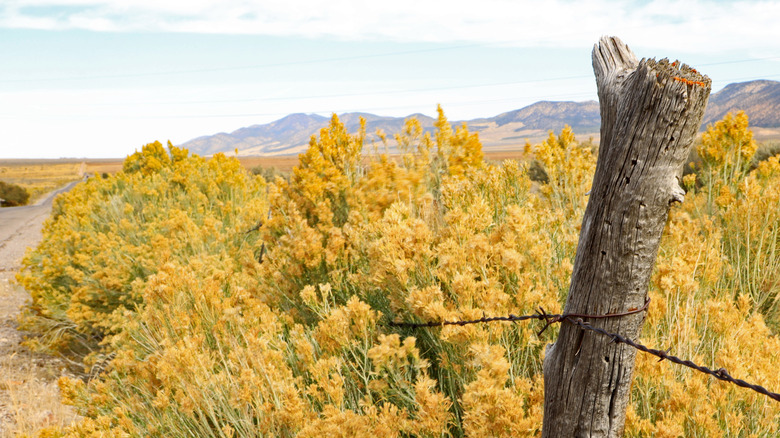The Gorgeous, Low-Maintenance Perennial All Bird And Butterfly Lovers Should Grow
Every hardworking gardener feels that beaming sense of pride when they see an array of local pollinators show up in their yard. If you're a new gardener, or looking to bring more pollinators to your yard and garden, there's one perennial you should absolutely grow: rubber rabbitbrush. The bright yellow flower is gorgeous and low-maintenance. Plus, it's perfect for attracting birds, butterflies, bees, and other native pollinators to your garden.
Rubber rabbitbrush, whose scientific name is Ericameria nauseosa, is native to the western United States and thrives in arid zones. In summer, pollinators like butterflies and bees flock to rabbitbrush, thanks to the plentiful pollen found in its abundant golden blooms. In late summer and fall, when rabbitbrush blooms reach their peak, small bees often use the plant as housing. In winter, birds find sustenance from the seedhead.
Gardeners love the perennial because it is a low-maintenance plant you don't have to fertilize; plus, it grows quickly, doesn't require much water, and spreads quickly on its own (although it is considered invasive in ideal conditions, so you may need to keep an eye on yours). The plant is also drought tolerant, and mature plants can handle some frost, making it popular with fans of xeriscaping and those living in desert areas.
How to grow rubber rabbitbrush
This beautiful bloom thrives in USDA hardiness zones 4 to 9. Rubber rabbitbrush can be planted in mildly acidic to mildly alkaline soil and in a wide variety of soil textures, like clay or sand. It'll need a spot in your garden that receives at least six hours of full sun for it. Ensure that your planting site is weed-free and offers reliable drainage (you can add in a little drainage-supporting compost here if it doesn't). We also recommend planting it a good distance from any windows in your home. Why? Some subspecies have a foul scent, especially when the leaves are crushed, with notes ranging from rubbery to wet armpit (hence its species root word being "nausea").
If you plant seed starters indoors, harden off the seeds before transplanting them. It's recommend to sow the seeds in the fall and then move the seedlings to your garden once the soil warms in spring. When planting, ensure they land 2 to 3 feet apart so there's room to grow, and remember that seedlings need regular watering until they get established (when they can live on very little water). Rabbitbrush grows deep roots, too, making it a boon to windy areas and those with erosion issues.
In late winter to early spring, rubber rabbitbrush benefits from an annual pruning, but make sure you avoid common pruning mistakes. It can grow up to 7 feet tall in ideal conditions but also thrives as a shrub, so you can prune it to keep it compact and looking appealing. With that, you're ready to enjoy this gorgeous and low-maintenance perennial.

